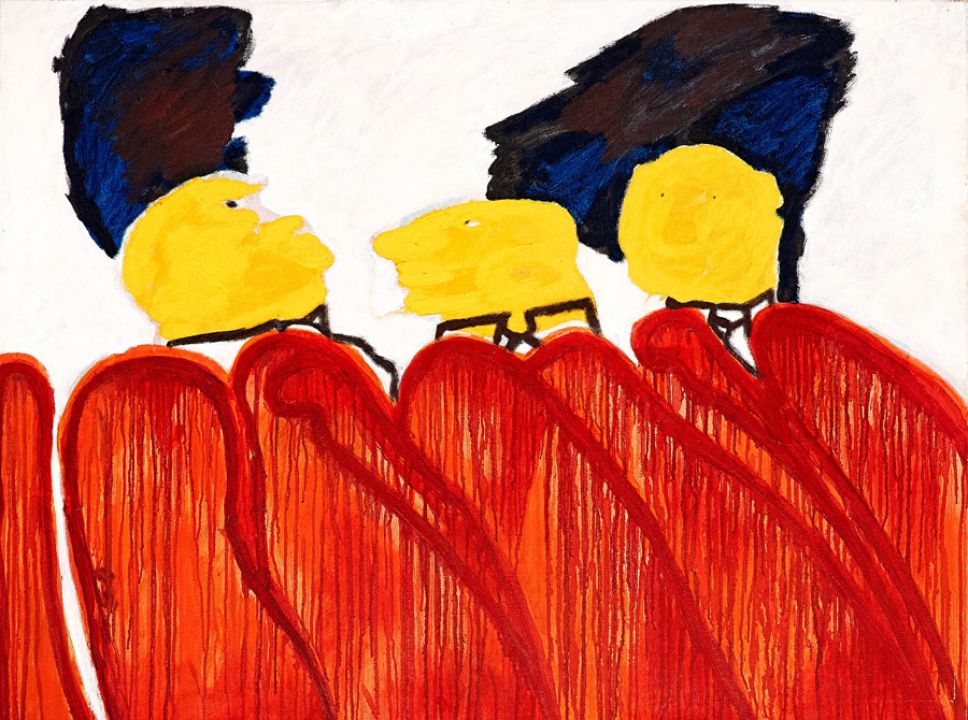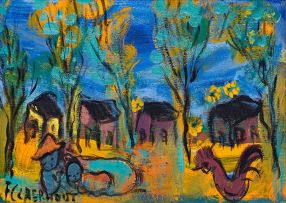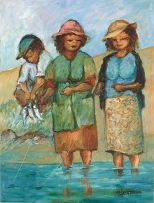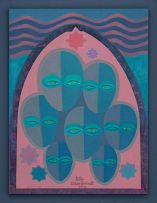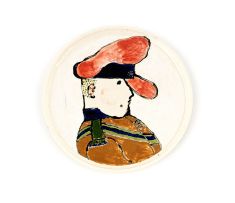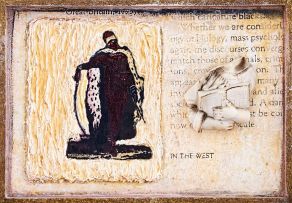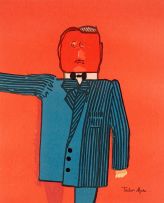Important South African and International Art
Live Auction, 9 November 2015
Session 2
Incl. Buyer's Premium & VAT
About this Item
signed, dated 1999, inscribed with the title and medium on the reverse
Notes
In the 2002 monograph edited by Brenda Atkinson, still the seminal work on Hodgins, essayist and critic Ivor Powell selects A Colloquy of Scoundrels as a "relatively random example" to represent central and important themes in Hodgins'ouvre.1 He argues particularly that ambiguity is the definitive characteristic of Hodgins' work, and central to the effect it produces.
"[T]he heads of the three figures in A Colloquy of Scoundrels only just cross the threshold from being meaningless blobs to acquiring human identity. They do this by the merest hints: the vaguest of shading for features; the most rudimentary of dots of eyes; and the crudest of lines that could be picking out collars (or maybe not)."2
A Colloquy of Scoundrels is typical of Hodgins' post-apartheid "humorous mode of critique", as Sue Williamson puts it, rather than his earlier, darker, more "acerbic ... critiques of power".3 The three figures belong to his "endlessly circulating retinue of fools for mocking": the businessmen in striped suits, politicians, military men and various others operating in the boys' clubs and corridors of power.4 These scoundrels' red cloak-like clothing suggests that they are cardinals, adding the Catholic church to the list of men in positions of institutional power Hodgins depicts.
The way they huddle suggests scheming and plotting rather than the true definition of a colloquy ("an informal conference on religious or theological matters").5 Their villainy is most obviously suggested in the way the red paint of their cloaks dribbles like blood, but as in many of Hodgins' works, the disfigurement of their heavy-limbed bodies and formless features convey corruption, cruelty and the humanity's basest impulses.
Their indistinct features, which seem momentarily identifiable and then swim back into abstraction, however, are what interest Powell most. Hodgins' figures are not so much depictions as evocations: a combination of semi-abstract, semi-surrealist forms that "creates tensions of possibility and virtuality, provoking the viewer to fill the canvas with associations, connections, subliminal and half-raised 'textlets' of his or her own.6
With particular reference to A Colloquy of Scoundrels, he notes how the minimal information provided by the almost-formless figures, which see-saw between representation and abstraction "becomes eloquent of the secrecy and shiftiness of the huddle".7 The way in which the formal ambiguity of this work dovetails with its particular subject to produce its effect, rather than being merely typical of Hodgins' work, can be seen as exemplary.
1. Ivor Powell. (2002) 'Through Ubu's eyes: Ambiguity in Hodgins' in Robert Hodgins, Cape Town: Tafelberg Publishers. Page 49.
2. Ibid.
3. Sue Williamson. (2009) 'Robert Hodgins' in South African Art Now, New York: Collins Design. Page 186.
4. Ibid.
5. Collins English Dictionary - Complete & Unabridged 10th Edition. HarperCollins Publishers.
6. Ivor Powell. (2002) 'Through Ubu's eyes: Ambiguity in Hodgins' in Robert Hodgins, Cape Town: Tafelberg Publishers. Page 44.
7. Ivor Powell. (2002) 'Through Ubu's eyes: Ambiguity in Hodgins' in Robert Hodgins, Cape Town: Tafelberg Publishers. Page 49.
Literature
Fraser, Sean (ed.) (2002) Robert Hodgins, Tafelberg: Cape Town. Illustrated in colour on page 49.
